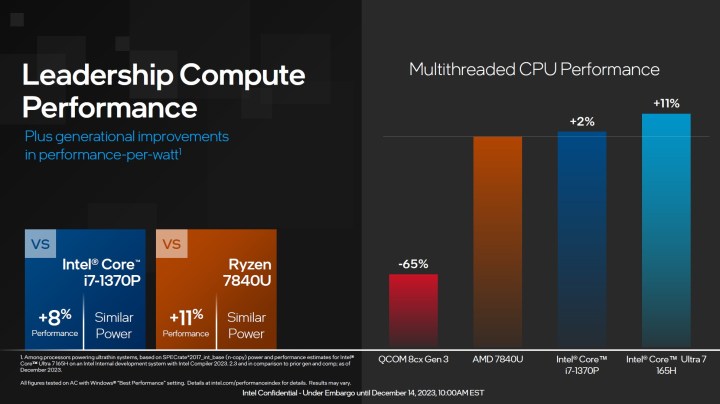
Intel’s Meteor Lake processors represent more than just a new generation. It’s a fresh start for Intel — a cycle it seems to find itself in every few years — and the birth of the AI PC. Most importantly, it’s a sign that Intel can deliver on its road map with a fresh generation of processors built on a new node.
Meteor Lake ushers in the Intel 4 node, which we first heard about nearly three years ago with the launch of 11th-gen CPUs. It also marka the start of the Core Ultra era of CPUs, along with a consolidation of Intel’s massive mobile CPU lineup. Now, processors fit into two camps: U-series for thin and light laptops, and H-series for more powerful machines.
H-series CPUs fit either in the 28-watt or 45W camp, depending on the model. They’re replacing the P-series that we’ve seen with previous generations. Intel has four H-series chips available now, with an additional one coming in the first few months of next year. You can see how the specs break down below.

Perhaps most exciting about these CPUs is that they include Intel’s excellent Arc graphics, which we’ve seen in GPUs like the A770 and A750. Intel claims this new integrated GPU is twice as fast as Intel’s previous integrated graphics in games. In terms of actual performance, Intel showed the new Arc graphics reaching 62 frames per second (fps) at 1080p in Ghostrunner 2 with medium settings. Intel’s Core i7-1370P could only reach 26 fps in the game, according to Intel.

Intel also says these integrated graphics can match or beat the graphics found in the AMD Ryzen 7 7840U. We’ve seen this CPU at work in devices like Asus’ ROG Ally and the Lenovo Legion Go. If Intel is able to offer higher performance, we may see some Intel-powered handheld gaming PCs before too long.
The integrated GPUs come with a big caveat, however. They’re not available on all Meteor Lake CPUs, and they’re only supported if the laptop has 16GB of RAM or higher. Intel says this is due to the shared memory pool of the Arc GPU, and that 8GB isn’t enough for the system and the graphics.
Unfortunately, the CPU improvements aren’t as impressive, despite Meteor Lake moving to the Intel 4 node. Intel says the Core Ultra 7 165H manages an 11% lead over the Ryzen 7 7840U in multithreaded performance and a 12% improvement in single-threaded performance. Interestingly, Intel’s materials show that last-gen’s Core i7-1370P is even faster in single-threaded performance.
There are also U-series CPUs, which don’t include Arc graphics. They instead fall back to Intel’s Iris graphics we’ve seen for the past several generations. It makes sense, as they are 9W or 15W CPUs targeting ultrathin laptops with a clear focus on battery life.
Just like with the H-series, Intel has four U-series chips that are available now. Intel says it’s launching an additional two U-series chips in the first part of 2024.
Across both the H-series and U-series chips, Intel is including a Neural Processing Unit (NPU). All Meteor Lake CPUs we know about right now come with this dedicated AI processor, and that’s really Intel’s big focus this generation: the AI PC.
It’s not just the NPU, though. Intel made it clear that it thinks of the entire system-on-a-chip (SoC) as an AI package, with the CPU, GPU, and NPU all stepping in to perform different AI tasks. Intel brought receipts this time, too, rather than relying on the vague NPU claims we’ve heard over the past six months.

In real applications, Intel claims the Core Ultra 7 165H is anywhere from 1.2 times faster than the Ryzen 7 7840U in applications like DaVinci Resolve with an AI mask to a massive 5.4 times faster in Stable Diffusion in GIMP. AMD’s chip has a dedicated NPU, as well.
It looks like the big difference for Intel is how it’s able to utilize the different hardware on the SoC. Intel says Meteor Lake has three AI accelerators — the NPU, the GPU, and int8 instructions on the CPU — and utilizing all three should give you the best performance in AI-powered applications.

As for if that’s true, we’ll just have to wait and see. As it stands, there aren’t a ton of AI applications that are better run locally than they are on the cloud. Intel’s focus seems to be offloading background tasks to the NPU. Background blur, for example, could run on the NPU instead of the GPU, freeing it up to boost gaming performance. It’s hard to know now if that offloading will make a practical difference, though.
As for the CPUs themselves, they aren’t great out of the gate. We noticed some improvements in hands-on testing with Meteor Lake, but not on the scale of what we expect out of a full node shift. We’re still in the early days of Meteor Lake laptops, however, and we expect to see dozens of more designs debuted at CES in just a few weeks.
Editors' Recommendations
- Gamers are reportedly returning Intel Core i9 CPUs in droves
- Reviewers agree: Intel’s latest chip is truly ridiculous
- Intel CPU gaming crashes are causing an uproar
- A major era in Intel chip technology may be coming to an end
- Intel’s awkward transition year






